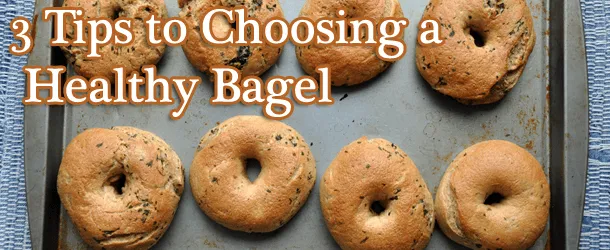
- Share on Facebook1
- Share on Pinterest
- Share on Twitter
When bagels first came to America, they were sold by street vendors who displayed them on long wooden dowels. Boy, have bagels come a long way in the last 130 years! These days, you can find bagels everywhere: in grocery stores, convenience stores, bakeries, coffee shops, and diners.

Bagels are also increasing in variety. Do you want plain, garlic, cinnamon-raisin, whole grain, “everything,” or thin style bagels? And they come in a variety of sizes. While mini-sized bagels are available, the size of a standard bagel varies widely, from the size of a tennis ball to larger than a softball.
With so many choices, how do you know which is the best for your taste and health? We’ve scoured restaurants and markets to determine which bagels are your best bet. A bagel can make a healthy breakfast, lunch, or snack if you keep the following tips in mind:
1. Great grains. A bagel at meals or snacks is a great opportunity to get some of your recommended daily whole grains, but don’t let the word “grain” in the title fool you. To ensure you’re getting the most whole grains for your buck, look for a Whole Grains Council stamp on the package and read the ingredient list to make sure the first grain listed is a whole grain.
2. What’s on top? A “schmear” of cream cheese may be the most common bagel accompaniment, but you can gain a nutritional boost if you vary your toppings. Try a tablespoon or two of peanut butter or a scrambled egg between the halves for a dose of protein. Or top each half with sliced bananas or strawberries to net a serving of fruit.
3. Size matters. We found bagels ranging in size from just over one ounce to almost five ounces. Given that a U.S. Department of Agriculture serving from the grain group is one ounce, for most people a two-ounce bagel, about the diameter of a baseball, is usually a decent portion size. When you’re eating out, you can eyeball the appropriate size, but in the grocery store just flip your bagel bag over to read the nutrition information, then decide if you should eat a whole bagel or just half.
– Heidi McIndoo, M.S., R.D
Reprinted with permission from Environmental Nutrition, a monthly publication of Belvoir Media Group, LLC. 800-829-5384.www.EnvironmentalNutrition.com.
(c) 2012 BELVOIR MEDIA GROUP DISTRIBUTED BY TRIBUNE MEDIA SERVICES, INC.
- Share on Facebook1
- Share on Pinterest
- Share on Twitter

